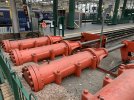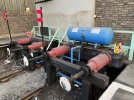I would think that over the years buffers have got more sophisticated and powerful: the types you see now have been installed over many years and were sometimes the latest design, while at other locations they would have been whatever was available. They probably remain in place for many years, so there are many variants of gradually evolving and improving designs. When they are replaced there would be a risk assessment, although in days of yore this would probably often consist of someone looking at it and saying, “I reckon we need a type X.” The decision would be made after taking into account the gradient, whether trains run into the line or are just shunted there, whether it is a passenger line, how often it is used, etc.: large hydraulic buffers are excessive for a siding normally used for just the odd van, while a platform line that sees terminating trains would need more than just a simple rail-built one. And of course hydraulic buffers have the advantage of bringing a train to a halt less suddenly than simpler ones, but they are too expensive to fit everywhere.



